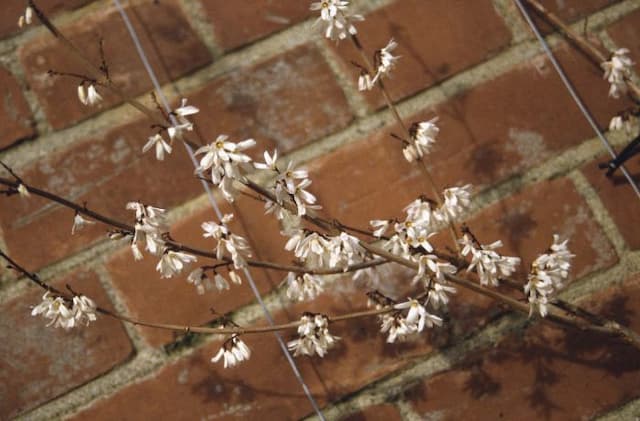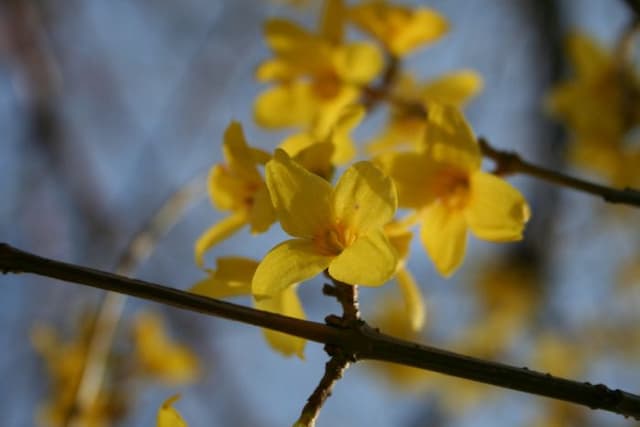Lemon-scented Jasmine Jasminum azoricum

ABOUT
The plant known commonly as the Lemon Scented Jasmine is a lush, evergreen vine with a twining growth habit that allows it to climb structures and supports. Its leaves are dark green, glossy, and oval-shaped, which provide a handsome backdrop to its highly fragrant white flowers. The blooms, which appear in clusters, are composed of delicate, star-shaped petals that unfurl from pink-tinted buds, typically present throughout warmer months or year-round in ideal climates. These blossoms are especially noted for their intense, sweet fragrance that can perfume the air, particularly in the evening. The overall impression of Lemon Scented Jasmine is one of an attractive and aromatic plant that can add both visual and olfactory appeal to gardens and landscapes.
About this plant
 Names
NamesFamily
Oleaceae
Synonyms
Azores Jasmine, Lemon-Scented Jasmine, River Jasmine
Common names
Jasminum trifoliatum, Jasminum odoratissimum, Jasminum azoricum var. parviflorum, Jasminum azoricum var. latifolium, Jasminum azoricum var. grandiflorum, Jasminum canariense, Mogorium azoricum
 Toxicity
ToxicityTo humans
The Lemon-scented Jasmine (Jasminum azoricum) is not known to be toxic to humans. There is no well-documented evidence or case reports that consuming this plant causes poisoning in humans. That said, it is generally recommended to avoid ingesting any plant parts if they are not known to be edible, as they might cause an upset stomach or an allergic reaction in sensitive individuals.
To pets
Lemon-scented Jasmine (Jasminum azoricum) is not commonly listed as a toxic plant to pets such as dogs and cats. There is limited information on its toxicity, but it does not appear in the majority of toxic plant databases for pets. However, as with humans, ingestion of non-edible plants can sometimes lead to gastrointestinal upset in pets. If you suspect your pet has ingested a large amount of this plant and is showing signs of illness, it is best to consult with a veterinarian.
 Characteristics
CharacteristicsLife cycle
Perennials
Foliage type
Evergreen
Color of leaves
Green
Flower color
White
Height
8-10 feet (2.4-3 meters)
Spread
4-6 feet (1.2-1.8 meters)
Plant type
Climber
Hardiness zones
9
Native area
Madeira
Benefits
 General Benefits
General Benefits- Aesthetic Appeal: The plant's attractive white flowers and evergreen foliage enhance the beauty of gardens and landscapes.
- Fragrance: Jasminum azoricum is renowned for its sweet, exotic scent that can perfume an entire garden or outdoor space.
- Pollinator Attraction: It attracts pollinators such as bees, butterflies, and birds, contributing to the health of the ecosystem.
- Versatility: Suitable for trellises, walls, and arbors, allowing for versatile landscaping options.
- Growth Habit: Its tendency to grow quickly provides rapid coverage and can be used for privacy screening.
- Year-Round Interest: With perennial growth in suitable climates, it offers visual interest throughout the year.
 Medical Properties
Medical PropertiesThis plant is not used for medical purposes.
 Air-purifying Qualities
Air-purifying QualitiesThis plant is not specifically known for air purifying qualities.
 Other Uses
Other Uses- Jasmine-scented products: The intensely fragrant flowers of Jasminum azoricum are used to produce perfumes and scented oils that imbue products with its sweet aroma.
- Aromatherapy: The scent of lemon jasmine can be used in aromatherapy to foster a relaxing and pleasant environment.
- Decoration: Both cut flowers and the living plant of lemon jasmine are often used for decorative purposes in homes and at events due to their visually appealing flowers.
- Garden design: Lemon jasmine is popular in ornamental garden design for its lush foliage and climbing habit that can adorn trellises and walls.
- Culinary use: Although not commonly consumed, lemon jasmine flowers can be used in small quantities to flavor desserts, teas, and sweet dishes.
- Fabric fragrance: Dried flowers of lemon jasmine might be placed in drawers or wardrobes to impart a pleasant scent to clothing.
- Cultural practices: In some cultures, lemon jasmine flowers are used in ceremonial garlands and offerings.
- Flower art: Lemon jasmine flowers may be used in the art of flower arrangement, like Ikebana, due to their aesthetic appeal.
- Potpourri: The flowers can be dried and added to potpourri mixtures for a long-lasting jasmine fragrance in homes.
- Holiday decorations: During festive seasons, lemon jasmine can be used to create natural wreaths and other decorations for its green foliage and white flowers.
Interesting Facts
 Feng Shui
Feng ShuiThe Lemon-scented Jasmine is not used in Feng Shui practice.
 Zodiac Sign Compitability
Zodiac Sign CompitabilityThe Lemon-scented Jasmine is not used in astrology practice.
 Plant Symbolism
Plant Symbolism- Love: Jasminum azoricum, commonly known as Lemon Scented Jasmine, often symbolizes love and affection, making it a popular choice in romantic settings and gardens dedicated to love.
- Beauty: Its delicate white flowers and sweet fragrance are seen as a representation of beauty, both inner and outer, and often used in beauty rituals and products.
- Purity: The pure white color of Lemon Scented Jasmine's blooms are commonly associated with innocence and purity, used in various cultural ceremonies to symbolize these virtues.
- Sensuality: With its intoxicating scent, this plant is frequently linked to sensuality and intimacy, capturing the essence of romantic and passionate moments.
- Femininity: Lemon Scented Jasmine is sometimes symbolic of femininity, embodying the soft, nurturing, and delicate aspects of womanhood.
- Good Luck: In some cultures, gifting this jasmine variety is considered to bring good luck, especially in matters of love and romance.
 Water
WaterThe Lemon-Scented Jasmine needs to be watered whenever the top inch of soil feels dry to the touch, which can vary depending on the environment but often translates to about once a week. In the growing season, water generously, allowing water to run through the drainage holes, but do not let the pot sit in water. During the winter, reduce watering to every two weeks, giving enough water to keep the soil barely moist. As a general rule, use approximately 16 ounces of water for small pots up to 1 gallon for larger pots each time you water, adjusting according to the plant's response and environmental conditions.
 Light
LightThe Lemon-Scented Jasmine thrives in bright, indirect light and should be positioned where it receives this light for most of the day. A spot near a south or west-facing window with a sheer curtain to diffuse the direct sunlight is ideal. However, it can tolerate some light shade, but too much shade can lead to fewer flowers.
 Temperature
TemperatureThe Lemon-Scented Jasmine prefers temperatures between 60°F and 75°F for optimal growth. It can tolerate minimum temperatures down to 50°F, and maximum temperatures up to 90°F, but prolonged exposure to these extremes can be harmful to the plant. The ideal conditions are a consistent temperature within the preferred range, avoiding fluctuations such as cold drafts or heat from appliances.
 Pruning
PruningPrune the Lemon-Scented Jasmine in late winter or early spring before new growth starts. This promotes a bushier growth habit, encourages more flowers, and removes any dead or diseased wood. Lightly trim the plant to maintain its shape and size, and execute more extensive pruning every few years to rejuvenate older plants. Pruning just after the blooming cycle can also be beneficial to shape the plant and encourage new growth.
 Cleaning
CleaningAs needed
 Soil
SoilRiver Jasmine thrives in well-draining soil enriched with organic matter, such as a mix of loam, peat, and sharp sand. Aim for a soil pH between 6.0 and 7.5 for optimal growth.
 Repotting
RepottingRiver Jasmine should be repotted every 2 to 3 years to refresh the soil and accommodate root growth. It is best to repot in spring or early summer.
 Humidity & Misting
Humidity & MistingRiver Jasmine prefers a humidity level around 40-50%. It thrives in environments with moderate to high humidity but can tolerate lower levels.
 Suitable locations
Suitable locationsIndoor
Place in bright, indirect light and keep the soil moist.
Outdoor
Provide full sun to partial shade and protect from frost.
Hardiness zone
9-11 USDA
 Life cycle
Life cycleJasminum azoricum, commonly known as the lemon-scented jasmine, begins its life as a seed, which, when sown in well-drained soil and given proper warmth, will germinate. Upon germination, the seedling emerges and develops into a young plant with characteristic glossy, green leaves. As it matures into an adult plant, it begins to produce fragrant, white flowers, particularly during late spring and summer. After pollination, these flowers may develop into small black berries, which are the fruit of the plant containing seeds, thus completing the reproductive cycle. Lemon-scented jasmine is a perennial plant, meaning it lives for several years, continuously growing, flowering, and producing seeds throughout its life. It can also be propagated vegetatively through stem cuttings, leading to the growth of new plants that are genetically identical to the parent.
 Propogation
PropogationPropogation time
Spring to Summer
The most popular method of propagating Jasminum azoricum, commonly known as the Lemon-Scented Jasmine, is through semi-hardwood cuttings. This technique typically takes place during the summer when the plant's growth is most active. To propagate, one selects healthy, semi-hardwood stems from the current year's growth and cuts them to a length of about 4 to 6 inches (approximately 10 to 15 centimeters). The lower leaves are removed to expose the nodes and the cut end is often dipped in rooting hormone to encourage root development. The cutting is then planted in a well-draining soil mix, ensuring that at least one node is buried where roots can form. The cutting should be kept in a warm, humid environment with indirect light until roots have established, which can be verified by gentle tugging to feel resistance after a few weeks. Once rooted, the cutting can be transplanted to a larger pot or to its final location in the garden.

![Forsythia [Marée d'Or]](/_next/image?url=https%3A%2F%2Fplants-admin.emdemapps.com%2Fimages%2Fplants%2F%2Fimages%2F604b5d7568293.png&w=640&q=75)







